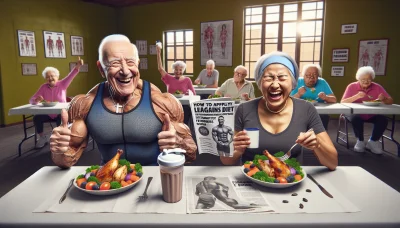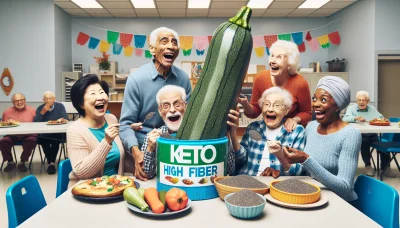Leangains meal plan Quiz
Test Your Knowledge
Question of
Understanding the Leangains Protocol
The Philosophy of Intermittent Fasting
The Leangains protocol is a revolutionary approach that combines intermittent fasting with weight training. It's centered on the idea that strategic fasting and feeding periods can significantly enhance fat loss and muscle growth. This method promotes an eating pattern focused on 16 hours of fasting followed by an 8-hour feeding window, challenging traditional dietary norms.
Intermittent fasting under the Leangains model is more than just a dietit's a lifestyle change aimed at improving longevity and health. The practice encourages the body to utilize fat stores for energy, potentially leading to improved insulin sensitivity and reduced inflammation. It's not merely about when you eat; it's about aligning your body's natural hormonal fluctuations with your eating schedule for optimal health.
Health Benefits of Fasting Windows
Fasting windows are pivotal in the Leangains protocol, offering numerous health benefits such as enhanced cognitive function and reduced oxidative stress. These periods without food intake push the body to burn fat for fuel, which can lead to significant weight loss and improved metabolic health. Moreover, fasting has been linked to better heart health and increased cellular repair processes.
How Fasting Influences Metabolism
Fasting acts as a metabolic switch, shifting the body from glucose-based energy to ketones derived from fatty acids. This transition can boost metabolic rate and improve fat oxidation, making it easier to maintain or lose weight. Additionally, intermittent fasting may increase levels of human growth hormone (HGH), further aiding in fat loss and muscle preservation during weight training.
The Role of Macronutrient Ratios
The Leangains protocol emphasizes the importance of macronutrient ratiosspecifically, a higher intake of protein combined with managed levels of carbohydrates and fats. Protein is paramount for muscle repair and growth, especially when combined with resistance training. Carbohydrates and fats are then adjusted based on individual energy needs and workout intensity.
Balancing Proteins, Carbs, and Fats
Balancing macronutrients is crucial in the Leangains method. Protein serves as the cornerstone of every meal to support muscle synthesis and satiety. Carbohydrates are strategically consumed around workouts when the body's insulin sensitivity is at its peak. Fats are typically lower on training days but play a vital role in hormone production and overall health on rest days.
Customizing Your Macros for Muscle Gain
Customization is key in tailoring macronutrient ratios for muscle gain within the Leangains framework. An individual's total calorie intake should factor in their basal metabolic rate plus additional energy expended during workouts. From there, protein intake remains consistently high while carbs are increased on training days to replenish glycogen stores and fats are moderated accordingly.
- High-Protein Focus: Aim for a high protein intake to support muscle recovery and growth.
- Carb Cycling: Increase carbohydrate intake on training days for energy; reduce on rest days.
- Fat Moderation: Adjust fat intake depending on your carb consumptionless on training days, more on rest days.
- Total Calorie Count: Ensure total calorie intake supports your goals of either maintenance, muscle gain or fat loss.
- Nutrient Timing: Align nutrient intake with your workout schedule for optimal performance and recovery.
- Dietary Flexibility: Adapt macronutrient ratios based on personal progress and energy levels.
- Micronutrient Consideration: Don't neglect vitamins and minerals which are essential for overall health.
- Consistency is Key: Adherence over time will yield the best results; avoid drastic day-to-day changes.
Workout Scheduling and Nutrition Timing
Pre- and Post-Workout Meal Strategies
To maximize the effects of each workout session under the Leangains protocol, pre- and post-workout nutrition timing is critical. Consuming a portion of daily carbohydrates before exercising can fuel intense training sessions while post-workout meals rich in protein aid recovery. This strategic timing ensures that nutrients are available when they're most needed for performance enhancement and muscle repair.
Aligning Meal Times with Training Intensity
The alignment of meal times with workout intensity is another cornerstone of the Leangains approach. On heavy lifting days, larger meals should coincide with post-workout periods when your muscles are primed for nutrient uptake. Conversely, lighter meals can be scheduled on rest or low-intensity days since energy requirements are naturally decreasedoptimizing nutrient utilization across different phases of activity.
Crafting Your Leangains Meal Plan
Calculating Your Caloric Needs
Understanding your caloric needs is the cornerstone of an effective Leangains meal plan. It's not just about counting calories, its about making each one count towards your fitness goals. This begins with calculating the energy your body requires at rest, known as your Basal Metabolic Rate (BMR).
Determining Basal Metabolic Rate (BMR) : Your BMR is the number of calories your body needs to maintain basic physiological functions like breathing and circulation. Various formulas exist to estimate BMR, but for accuracy, consider using online calculators or consulting a professional.
Adjusting for Activity Level : Once you know your BMR, it's time to adjust that number based on your activity level. This includes workouts, walks, and even daily tasks like shopping. Remember, the more active you are, the more calories you burn so fuel up accordingly!
Meal Planning for Training Days
Training days on the Leangains program are all about fueling those intense workouts and supporting muscle growth. You'll need a diet rich in carbohydrates and proteins to replenish glycogen stores and repair muscle fibers.
High-Carb Meal Ideas : Focus on including complex carbohydrates like oats, brown rice, and sweet potatoes in your meals. These foods provide sustained energy that helps maximize performance during training sessions.
- Oatmeal with fruit and whey protein for breakfast.
- Brown rice with grilled chicken and vegetables for lunch.
- Whole-wheat pasta with lean beef sauce post-workout.
- Sweet potato mash with fish and greens for dinner.
Optimizing Protein Intake for Muscle Recovery : Aiming for 0.8 to 1 gram of protein per pound of body weight is crucial. Incorporate lean meats, dairy, or plant-based proteins evenly throughout the day to support muscle recovery.
Meal Planning for Rest Days
Rest days are just as important as training days in the Leangains protocol. They are designed to help your body recover while also focusing on fat loss by reducing carbohydrate intake and maintaining protein levels.
Low-Carb Meal Suggestions : On rest days, prioritize low-carb foods that provide essential nutrients without spiking insulin levels. Think leafy greens, nuts, seeds, and quality fats from avocados or olive oil.
- Eggs scrambled with spinach and mushrooms for breakfast.
- Tuna salad with mixed greens for lunch.
- Stir-fried tofu with assorted vegetables for dinner.
- A handful of almonds or a piece of cheese as snacks.
Managing Caloric Intake for Fat Loss : To promote fat loss on rest days, reduce your caloric intake slightly below maintenance level. Keep a close eye on portion sizes and avoid high-calorie snacks that can derail your progress.
Essential Foods for a Leangains Diet
Protein-Rich Foods to Include
The cornerstone of the Leangains diet is protein. High-quality proteins like chicken breast, turkey, and lean beef help maintain and build muscle mass. For vegetarians, tofu, tempeh, and seitan offer substantial protein content. Embrace these power-packed options to fuel your body's recovery and growth.
Fish, such as salmon and tuna, are not only protein-rich but also provide essential fatty acids. Eggs are another fantastic source; they're versatile and contain all the necessary amino acids. Incorporating a variety of protein sources ensures a balanced diet that supports your fitness goals.
Lean Meats and Plant-Based Alternatives
Lean meats like chicken and turkey breasts are staples in the Leangains protocol due to their high protein and low-fat profile. Red meats can be included occasionally for their nutrient richness. Plant-based eaters can opt for lentils, chickpeas, and black beans as excellent protein alternatives.
Importance of Amino Acid Profiles
Amino acids are the building blocks of proteins crucial for muscle repair and growth. Complete proteins containing all nine essential amino acids are vital for those practicing Leangains. Quinoa, buckwheat, and soy products are complete plant-based proteins that fit well within this dietary approach.
Selecting the Right Carbohydrates
Carbohydrates are not the enemy on the Leangains diet; it's about choosing the right type. Whole grains like brown rice, quinoa, and oats provide sustained energy and fiber. They're essential for supporting intense training sessions while aiding digestion and promoting satiety.
Whole Grain versus Refined Carbs
Whole grains should be your go-to carbs instead of refined options like white bread or pasta. The latter can cause spikes in blood sugar levels leading to energy crashes. Whole grains keep you fuller longer, helping you adhere to your calorie targets with ease.
Timing Carb Intake Around Workouts
- Aim to consume the majority of your carbs post-workout when your body's glycogen stores are depleted.
- Incorporate slow-digesting carbs pre-workout for steady energy release during your training.
- Consider carb cycling by aligning higher carb intake on training days for maximum performance.
- Maintain a lower carb intake on rest days to aid in fat loss while ensuring adequate fiber intake.
- Listen to your body's response to carb timing adjustments and tweak as necessary for optimal results.
Healthy Fats for Balanced Nutrition
Healthy fats are an integral part of the Leangains diet as they play a role in hormone production and overall health. Sources like avocados, nuts, seeds, and olive oil should be included daily. These fats support cellular function and provide energy without spiking insulin levels.
Omega-3s and Unsaturated Fats Sources
Omega-3 fatty acids found in fatty fish, flaxseed, and walnuts are particularly beneficial for their anti-inflammatory effects. Monounsaturated fats from sources like olive oil can help with heart health and weight management when consumed in moderation.
Managing Fat Intake Proportions
It's important to balance fat intake with other macronutrients according to personal goals within the Leangains framework. A general guideline is to keep fat at moderate levels, focusing on quality sources while monitoring overall caloric intake for either muscle gain or fat loss objectives.
Overcoming Common Dietary Challenges
Dealing with Hunger During Fasting Periods
When you're fasting, the sensation of hunger can feel overwhelming. But fear not! Understanding your body's hunger signals and knowing how to manage them is key. Implementing mindful eating practices and listening to your body's true hunger cues can make all the difference. Remember, it's not just about willpower; it's about strategy!
Satiety-Boosting Strategies are your secret weapon against hunger pangs during fasting. Incorporate foods high in fiber, protein, and healthy fats into your eating periods to help keep you fuller for longer. Foods like avocados, nuts, lean meats, and legumes can be game-changers. Plan your meals to include these satiety superstars!
Hydration and Its Role in Appetite Control cannot be overstated. Often, what we perceive as hunger is actually dehydration in disguise. Make water your best friend! Sipping on water throughout the day can help curb appetite and aid in weight management. Herbal teas and infused waters are also excellent choices for keeping hydration levels up and hunger levels down.
Addressing Nutritional Deficiencies
Nutritional deficiencies can sneak up on anyone, especially when dietary restrictions are in place. It's crucial to stay vigilant about the balance of nutrients in your diet. Deficiencies can lead to significant health issues over time, so identifying them early is imperative.
Identifying Common Shortfalls in Diet involves paying attention to symptoms that may indicate a lack of essential nutrients. Fatigue, hair loss, or brittle nails could signal that something is missing from your diet. Regular check-ups with a healthcare provider can help catch these deficiencies before they become problematic.
- Supplementation Recommendations:
- Vitamin D - Essential for bone health and immune function.
- Omega-3 Fatty Acids - Important for heart health and cognitive function.
- Iron - Crucial for energy levels and combating anemia.
- Fiber - Aids digestive health and can be low in modern diets.
- Magnesium - Supports muscle and nerve function; often overlooked.
Dining Out and Social Events
Making Smart Choices at Restaurants doesn't have to mean sacrificing flavor or enjoyment. Start by scanning the menu for grilled, baked, or steamed options rather than fried ones. Don't hesitate to request modificationsmost restaurants are happy to accommodate dietary needs or preferences!
Dining out while fasting? No problem! Plan ahead by checking the restaurant menu online and deciding what you'll order beforehand. It's all about timingalign your social plans with your eating windows when possible. And remember, there's no harm in enjoying a sparkling water with lemon while you socialize!
Sample Leangains Meal Plans and Recipes
Beginner's One-Day Meal Plan Example
Starting the Leangains journey can be thrilling! Imagine transforming your body and health with this powerful protocol. For beginners, it's vital to keep it simple. Your one-day meal plan should focus on high-protein foods, healthy fats, and fibrous vegetables. Think grilled chicken breast, avocado, and spinach salad!
The key to success is in the timing. With Leangains, you'll follow an intermittent fasting schedule. This means your first meal might not be until noon. But don't worry, your lunch will be a feast that fuels your body for hours perhaps a succulent salmon fillet with a side of quinoa and kale.
Breakfast, Lunch, and Dinner Breakdown
Breakfast is unique with Leangains it's not when you wake up, but rather when you break your fast. A robust meal packed with protein like eggs and turkey bacon after your fasting period will ignite your metabolism. For lunch and dinner, balance lean meats like turkey or beef with complex carbs such as sweet potatoes or brown rice.
Each meal should be a harmonious blend of macronutrients. A dinner that dazzles might include lean steak strips stir-fried with an array of colorful veggies over a bed of whole-grain rice. It's all about combining taste with nutritional value to create meals that are both satisfying and beneficial.
Snacks and Timing Considerations
When it comes to snacks, think almonds or Greek yogurt simple yet powerful! These are perfect for keeping hunger at bay between meals without breaking your caloric bank. The magic is in the macro mix; prioritize protein and fiber-rich options to keep you full and focused.
Timing is everything in Leangains! Aligning meal times with workout schedules maximizes muscle gains and fat loss. Aim to consume the bulk of your calories post-workout when your body is primed for nutrient absorption.
Advanced Leangains Weekly Meal Planner
Structuring a Diverse Weekly Menu
For the advanced Leangains enthusiast, variety is the spice of life and nutrition! A diverse weekly menu ensures you get all essential nutrients while keeping taste buds tantalized. Rotate proteins like fish, chicken, and tofu throughout the week for a spectrum of amino acids.
Don't shy away from experimenting with different vegetables and grains each day to provide a wide range of vitamins and minerals. This approach not only supports overall health but also prevents dietary boredom crucial for long-term adherence to any meal plan.
Prepping Meals in Advance for Convenience
- Plan Ahead: Spend time each week planning out your meals to ensure variety and balance.
- Bulk Cooking: Prepare large quantities of staple foods that can be used in multiple meals throughout the week.
- Portion Control: Divide cooked foods into single-serving containers for ease of use.
- Mix It Up: Create different flavor profiles for similar ingredients to avoid monotony.
- Storage Smarts: Store prepped meals properly to maintain freshness and prevent spoilage.
- Label Everything: Keep track of what you have on hand with clear labeling including dates.
- Snack Prep: Have ready-to-eat healthy snacks available to avoid reaching for less optimal choices.
- Ease into It: Start by prepping a few meals at a time before scaling up to a full week.
Delicious and Nutritious Recipe Ideas
High-Protein Recipes for Muscle Gain
The cornerstone of muscle gain lies within high-protein recipes that are both delicious and easy to make. Imagine sinking your teeth into a juicy grilled chicken breast marinated in aromatic herbs or savoring the rich flavors of a beef chili brimming with beans these meals aren't just fuel; they're feasts fit for champions!
Nutritional balance is paramount here; consider complementing these protein powerhouses with sides such as brown rice or steamed broccoli to round out the meal. The goal is twofold: satisfy your palate while providing the building blocks needed for muscle synthesis.
Tracking Progress and Adjusting Your Diet
Monitoring Body Composition Changes
Keeping track of your body composition is crucial to understanding the impact of your diet and exercise routine. Regularly monitoring changes can provide insights into how your body is responding, allowing for data-driven adjustments to your plan.
Using scales for weight tracking is a common method, but it can be misleading if not paired with body fat measurements. Weight alone doesn't distinguish between muscle and fat gain or loss, which is why incorporating body fat assessments provides a more complete picture of progress.
Using Scales and Body Fat Measurements
Scales are readily accessible tools that give you a quick snapshot of your weight, which can be an indicator of progress when used consistently under the same conditions. However, don't let daily fluctuations derail you; focus on long-term trends instead.
Body fat measurements, whether through skinfold calipers or advanced methods like DEXA scans, are essential for accurately tracking fat loss versus muscle gain. These measurements can guide your dietary choices and workout intensity by revealing the true nature of your weight changes.
The Importance of Progress Photos and Measurements
Progress photos offer visual evidence of changes that scales and numbers may not capture. They serve as motivational tools and objective records for comparison over time. Take them regularly from multiple angles in consistent lighting to track subtle shifts in body composition.
In addition to photos, taking regular body measurements with a tape measure can reveal reductions or increases in specific areas, helping you tailor your fitness regime to target lagging body parts effectively.
Adapting Your Meal Plan as You Evolve
Your nutritional needs will change as you progress in your fitness journey. It's important to adapt your meal plan to support continued growth or fat loss. This keeps your metabolism active and ensures you're providing your body with the fuel it needs.
When muscle gain is evident or physical activity levels increase, it may be necessary to up your caloric intake. This supports recovery and further muscle development, preventing plateaus in strength and size gains.
When to Increase Caloric Intake
If you're working out intensely but not seeing muscle gains or feeling constantly fatigued, it might be time to increase calories. This doesn't mean eating anything in sight; rather, focus on nutrient-dense foods that provide energy and aid recovery.
- Eat more complex carbs for sustained energy.
- Incorporate healthy fats for hormone regulation.
- Add extra protein to support muscle repair and growth.
- Monitor how these adjustments affect your progress.
- Avoid empty calories that offer little nutritional value.
Signs You Need to Adjust Your Macros
Your macronutrient balancecarbs, proteins, and fatsis pivotal in reaching fitness goals. If you hit a wall with weight loss or feel sluggish during workouts, reassessing macros is key. Seek guidance from a nutritionist if needed for precise adjustments tailored to your goals.
Persistent hunger or lack of satiety after meals may indicate insufficient protein or fiber intake. Conversely, feeling bloated or heavy could suggest an excess of carbohydrates or fats that need scaling back for optimal performance and health outcomes.
Learning from Setbacks and Plateaus
No fitness journey is without its hurdles. Setbacks and plateaus are normal but analyzing their causes helps prevent future occurrences. Whether it's stress, inadequate sleep, or overtraining, identifying the root cause enables targeted solutions.
Treating these challenges as learning opportunities fosters resilience and long-term adherence to a healthier lifestyle. Instead of getting discouraged, reassess and refine your approach based on what you've learned about your body's unique responses to diet and exercise.
Analyzing Causes of Plateaus
Integrating Supplements into Your Leangains Diet
The Role of Protein Powders and Bars
Protein powders and bars can be game-changers in your Leangains diet, providing a quick and convenient source of high-quality protein. They're perfect for those with busy lifestyles who might struggle to prep meals. But remember, they should complement, not replace, whole foods in your diet.
Whole food proteins come packed with essential nutrients that are often absent in processed options. They promote greater satiety and offer a richer array of amino acids. While convenience is king for many, the nutritional benefits of whole foods like chicken breast, fish, and legumes should not be underestimated.
Convenience versus Whole Food Proteins
When you're on the run or post-workout, protein supplements can save the day. They're quick to consume and require no preparation time. However, it's crucial not to let these supplements become a crutch. Whole foods provide a broader nutrient profile for holistic health benefits.
Reading Labels for Quality Ingredients
Not all protein supplements are created equal. It's vital to read labels carefully to ensure you're getting quality ingredients without unnecessary fillers or additives. Look for products with minimal ingredients and avoid those with high sugar content or artificial sweeteners that can hinder your progress.
Essential Vitamins and Minerals to Consider
Vitamins and minerals are pivotal in supporting metabolic processes, especially when following a Leangains diet. Adequate intake ensures your body functions optimally during both fasting and feeding windows. Supplementation may be necessary if your diet lacks variety.
Daily Recommended Intakes
Your daily vitamin and mineral needs depend on various factors including age, gender, and activity level. The Leangains diet emphasizes macronutrient balance, but micronutrients shouldn't be overlooked. A multivitamin can act as a nutritional safety net but cannot replace the complexity of nutrients found in whole foods.
Synergy with Macronutrients
Micronutrients work in harmony with macronutrients to fuel muscle growth and recovery. For instance, vitamins D and K2 support calcium absorptiona critical mineral for bone health amidst heavy lifting regimes. Ensure your supplement strategy covers these synergies to maximize gains.
- *
- Magnesium: Essential for muscle function and recovery; often lacking in modern diets. *
- Vitamin D: Crucial for bone health and immune function; supplementation may be needed, especially in less sunny climates. *
- Fish Oil (Omega-3s): Supports cardiovascular health and may aid joint flexibility. *
- Zinc: Important for testosterone production and overall immune function. *
- Iodine: Vital for thyroid health which regulates metabolism; can be sourced from seafood or iodized salt. *
- B Vitamins: Play a key role in energy metabolism; deficiencies can impact energy levels. *
- Iron: Especially important for menstruating women; critical for oxygen transport in the blood. *
- Fiber: Not a vitamin or mineral but essential for digestive health; consider a fiber supplement if intake is low.
Pre-Workout and Recovery Aids
Caffeine, Creatine, and Other Enhancers
Caffeine is a powerful stimulant that can enhance focus and increase endurance during workouts. Creatine monohydrate is well-researched for its ability to improve strength and lean muscle mass. Both can be valuable additions to your Leangains regimen when used judiciously.
Balancing Supplementation with Whole Foods
A balanced approach to pre-workout and recovery means using supplements strategically while prioritizing whole foods. Nutrient-dense meals will provide the majority of your dietary needssupplements should only fill the gaps or provide an extra edge when necessary.
Staying Motivated and Consistent with Your Diet Plan
Setting Realistic Goals and Expectations
Embarking on a diet journey can be exhilarating, but setting achievable targets is crucial for long-term success. Establish goals that challenge you without being overwhelming. This balance is the key to maintaining motivation and consistency.
Remember, progress takes time! Avoid the common pitfall of expecting immediate results. Instead, focus on incremental improvements. By doing so, you'll create a sustainable path forward that's less likely to lead to burnout or frustration.
Short-Term versus Long-Term Goals
Short-term goals act as stepping stones towards your ultimate objective. They provide a sense of achievement and help you stay on track. Think in terms of weekly or monthly objectives that contribute to your larger ambition.
In contrast, long-term goals are your endgame. They should be ambitious yet attainable, motivating you to push through the tough days. Visualize where you want to be in a year or more, and let that vision guide your daily choices.
Celebrating Milestones
Don't wait until you've reached your final goal to celebrate! Acknowledging milestones reinforces positive behavior and keeps your spirits high. It's about the journey as much as the destination.
- Celebrate every pound or inch lost.
- Reward yourself with non-food treats like a new outfit or a spa day.
- Share your successes with friends or on social media for added accountability.
Building a Supportive Community
A robust support system can make all the difference in sticking to your diet plan. Surrounding yourself with people who understand your goals can provide encouragement when you need it most.
Leverage social platforms or local groups to connect with others on similar paths. These connections can turn into valuable friendships that bolster your commitment to healthy living.
Finding Like-Minded Individuals
Finding peers who share similar diet goals can offer camaraderie and understanding. They know what you're going through and can provide insights from their own experiences.
Whether it's through online forums, group classes, or local meetups, these relationships foster an environment where everyone grows together.
Sharing Tips and Experiences
Sharing your journey opens doors to learning new strategies and avoiding potential pitfalls. It's a give-and-take relationship where everyone benefits from collective wisdom.
Don't hesitate to ask for advice or offer guidance when someone else is in need. This reciprocal exchange keeps the community thriving and supportive.
Keeping Your Diet Exciting and Enjoyable
Maintaining enthusiasm for your diet means keeping things fresh and pleasurable. A varied diet not only prevents boredom but also ensures a wide range of nutrients to support your health.
Creativity in meal preparation is a game-changer. Try new recipes regularly, experiment with exotic ingredients, and explore different cuisines to keep your taste buds intrigued!
Introducing New Foods and Recipes
Incorporating novel foods into your diet can reignite excitement in meal times. Discover unfamiliar fruits, vegetables, or whole grains each weekits like an adventure on your plate!
New recipes are not just fun; they can also be healthier alternatives to old favorites. Get creative in the kitchen by substituting ingredients with more nutritious options!
Experimenting with Different Eating Windows
If traditional meal times feel monotonous, consider experimenting with different eating windows such as intermittent fasting or smaller, more frequent meals throughout the day.
This approach can revitalize your eating schedule and may even boost metabolism or improve digestionjust ensure it aligns with your dietary needs and lifestyle!












